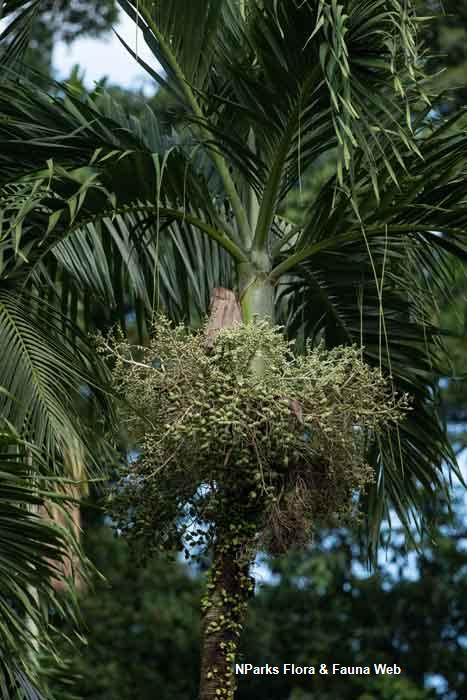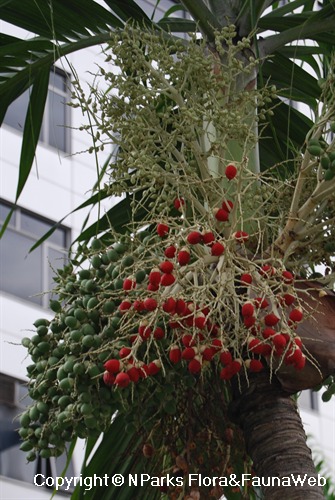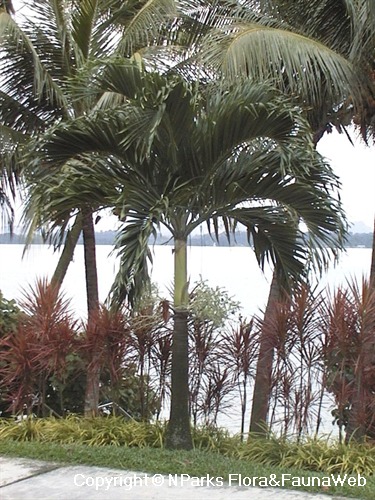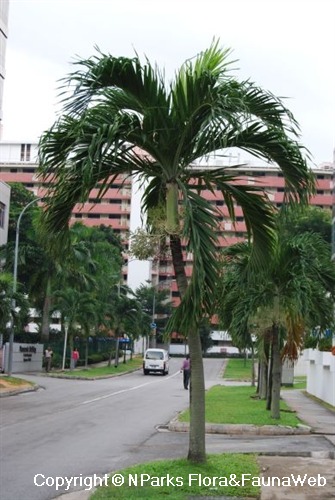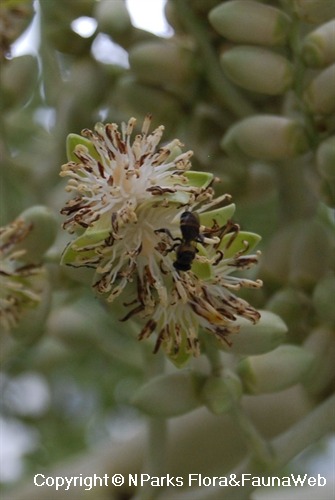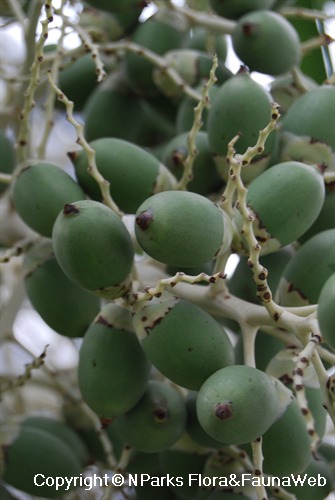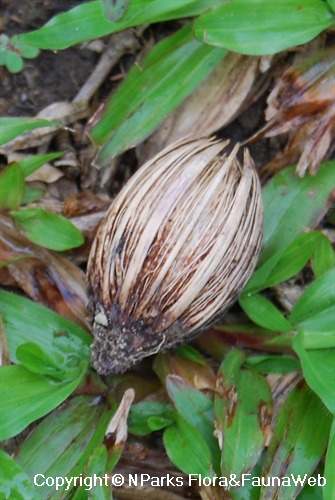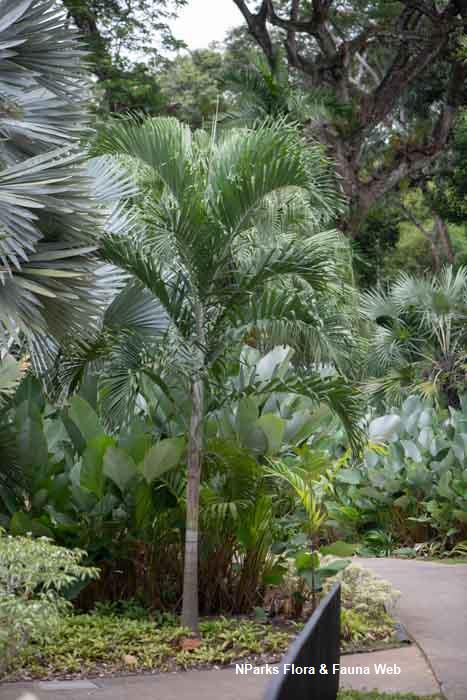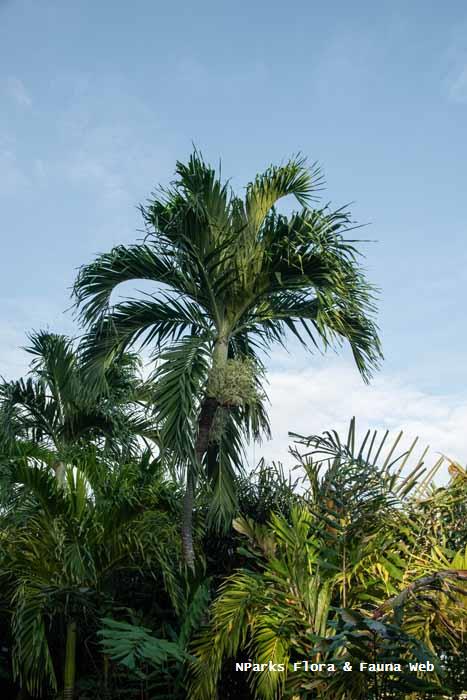
Back
Adonidia merrillii (Becc.) Becc.
| Family Name: | Arecaceae (Palmae) |
| Synonyms: | Normanbya merrillii, Veitchia merrillii |
| Common Name: | Manila Palm, Christmas Palm, Merrill's Palm, Adonidia Palm, Dwarf Royal Palm, 王棕, 大王椰子 |
Adonidia merrillii, commonly known as the Manila Palm, is a palm with a solitary habit. Its internodes are marked by distinct fine vertical wavy striations.
Name
Classifications and Characteristics
| Plant Division | Angiosperms (Flowering Seed Plants) (Monocotyledon) |
|---|---|
| Plant Growth Form | Palm (Solitary Habit) |
| Lifespan (in Singapore) | Perennial |
| Mode of Nutrition | Autotrophic |
| Plant Shape | Fountain (Palm-like) |
| Maximum Height | 5 m to 15 m |
| Maximum Plant Spread / Crown Width | 3.5 m |
Biogeography
| Native Distribution | Philippines |
|---|---|
| Native Habitat | Terrestrial (Primary Rainforest), Shoreline (Sandy Beach) |
| Preferred Climate Zone | Tropical |
Description and Ethnobotany
| Others - Plant Morphology | Growth Form: A palm with a single, erect trunk. Habitat: This species occurs in rainforests, open forests, steep limestone hills and areas along the coast, such as beaches near forests. It is found at altitudes of 10 - 100 m in the Philippines. Trunk: Trunk is grey with numerous circular leaf scars that are evenly spaced from top to bottom. Foliage: Large, pinnately compound leaves are arched upwards (1.5 - 2 m long), but the leaflets droop downwards (0.6 m long, 5 cm wide). The leafbases form a smooth, light green crownshaft that occurs above the trunk, but below the leaf blades. Flowers: Flowers are arranged in groups of three (two male flowers and one female flower) in long, branched inflorescences known as panicles (0.6 m long). Male flowers have a puffball-like appearance due to their numerous stamens. Fruits: Large bunches of ovoid fruits are classified as drupes (3 cm long, 1.5 cm wide). In the USA, the green fruits turn red at maturity during fall and winter. Landscaping: This species resembles the Royal Palm (Roystonea regia), but it is more compact. The crown is symmetrical and pleasing to the eye. Individuals may be planted singly, in small clumps of 2 - 3 individuals or in lines. It is often planted in parks, public and home gardens and along roadsides. It is also suitable for courtyards or lobbies where space is limited. You might plant 2 small individuals in the same pot for a fuller look. Cultivation: This species grows best in moist, but well-drained soils. Established plants can tolerate short periods of drought, nutrient poor or alkaline soils, as well as moderate amounts of salt and shade. It is not frost tolerant. Fertilize every other month with a 11-4-11 NPK fertilizer designed for palms. Mulch the plants to help retain soil moisture. This species is susceptible to mealy bugs and a fatal bacterial disease called "lethal yellowing." When growing this species indoors, provide at least 3.2 klx of light. Propagation: Propagate by seed. Soak the fruits in water (changing the water every day) until the flesh becomes soft. Then, use a knife to remove the flesh from the seed. People with sensitive skin should wear gloves when touching the flesh, because the flesh contains oxalate which may irritate the skin. Plant the seeds in moist peat mixed with perlite. Then, seal the pot in a plastic bag to retain moisture and place it under indirect sunlight. Fresh seeds naturally germinate in about 1 - 3 months. For faster germination, allow the seeds to soak in water for 3 days (changing the water daily) or scratch the seed surface until the endosperm is visible. Etymology: The genus "Adonidia" was named after the Roman sun god, Adonis. It was named Manila Palm, because it is often used in Manila (capital of the Philippines) for landscaping. |
|---|
Landscaping Features
| Desirable Plant Features | Ornamental Fruits |
|---|---|
| Landscape Uses | Suitable for Roadsides, Container Planting, Interiorscape/ Indoor Plant, Coastal, Beachfront / Shoreline |
Fauna, Pollination and Dispersal
| Pollination Method(s) | Biotic (Fauna) (Insects (Bee)) |
|---|---|
| Seed or Spore Dispersal | Abiotic |
Plant Care and Propagation
| Light Preference | Full Sun |
|---|---|
| Water Preference | Moderate Water |
| Plant Growth Rate | Moderate |
| Rootzone Tolerance | Saline Soils / Salt Spray, Poor Infertile Soils, Alkaline high pH Soils |
| Fertilizing | Fertilize every other month with a 11-4-11 NPK fertilizer designed for palms. |
| Diseases | Mealy bugs and a fatal bacterial disease called "lethal yellowing |
| Propagation Method | Seed |
Foliar
| Mature Foliage Colour(s) | Green |
|---|---|
| Mature Foliage Texture(s) | Smooth, Leathery |
| Foliar Type | Compound (Even-Pinnate) |
| Foliar Arrangement Along Stem | Spiral |
| Foliar Shape(s) | Non-Palm Foliage (Linear), Palm Fronds (Pinnate / Feather) |
| Foliar Venation | Parallel |
| Foliar Margin | Entire |
| Foliar Apex - Tip | Emarginate |
| Foliar Base | Truncate / Square |
| Typical Foliar Area | Macrophyll ( 182.25cm2 - 1640.25 cm2 ) |
| Leaf Area Index (LAI) for Green Plot Ratio | 2.5 (Palm - Solitary) |
Non - Foliar and Storage
| Trunk Type (Non Palm) | Woody |
|---|---|
| Trunk Type (Palm) | Solitary Habit, Aboveground |
| Mature Bark Texture | Smooth |
| Root Type | Underground (Fibrous Root) |
Floral (Angiosperm)
| Flower & Plant Sexuality | Unisexual Flowers , Monoecious |
| Flower Colour(s) | Cream / Off-White |
|---|
| Flower Symmetry | Radial |
| Individual Flower Shape | Stellate / Star-shaped |
| Inflorescence Type | Panicle |
| Flower Lifespan on Plant | Several Days |
| Flowering Habit | Polycarpic |
Fruit, Seed and Spore
| Mature Fruit Colour(s) | Red |
|---|---|
| Fruit Classification | Simple Fruit |
| Fruit Type | Fleshy Fruit , Drupe |
Image Repository
Others
| Master ID | 1395 |
|---|---|
| Species ID | 2688 |
| Flora Disclaimer | The information in this website has been compiled from reliable sources, such as reference works on medicinal plants. It is not a substitute for medical advice or treatment and NParks does not purport to provide any medical advice. Readers should always consult his/her physician before using or consuming a plant for medicinal purposes. |

